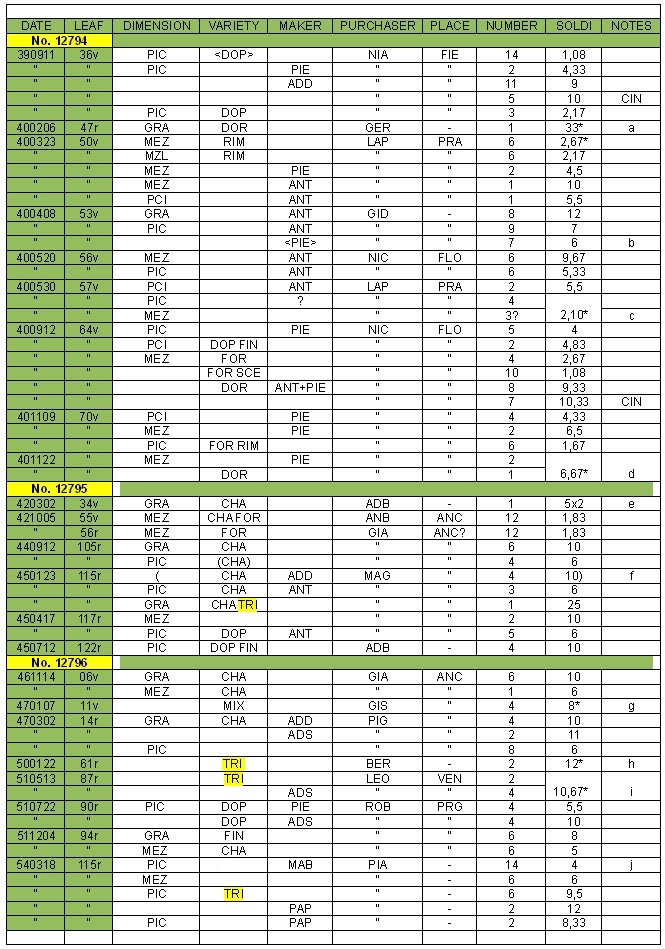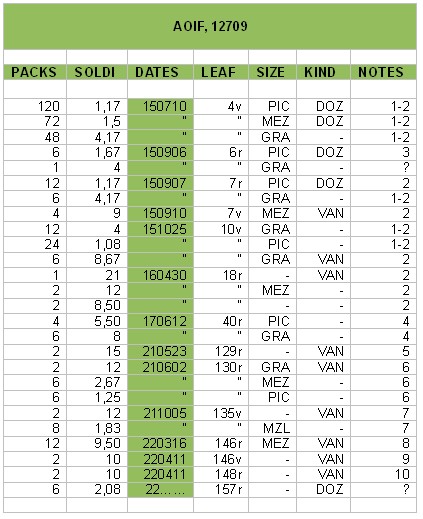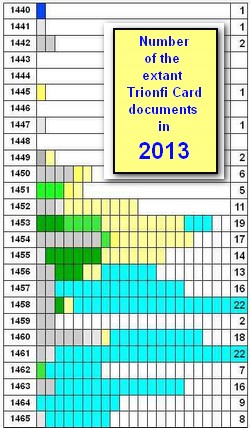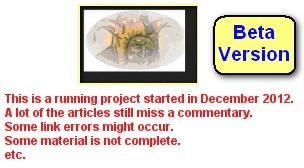Purchasers of decks
composed by Lothar Teikemeier, last update 06.12.2012
Source 1: (Lapini family 1415-22)
Source 3: (Puri family)
|
|
Sources
Sources are taken from the sale lists in the articles of Franco Pratesi to Lapini family, Puri family and the silk dealers.| SOURCE 1: Lapini family 1415 - 1422 |
| Quote from Franco Pratesi: Naibi traded at Lapini Store, from 1415 on (2012). |
Naibi sold in 1415-1422The book in question is the first of the series, and in principle should cover the long time interval from 1415 to 1441. Unfortunately, its second part has been severely damaged and only the lower part of the pages can be read; moreover, the records themselves are there less detailed and complete. The handwriting is less fine than average, everywhere, but in the second half of the book it becomes hard to read. In conclusion, we should be satisfied, at least for the moment, with the few years for which I have been able to get the data of the following Table. As in other notes, the date is expressed as 14yymmdd and the price everywhere in soldi, with an approximation to hundredths of them, which did not correspond to any coin of the time (thus, for ex. s.8,67 should correctly be read as s.8d.8).
As mentioned before, the main reason of satisfaction is that these years are so early for playing card production that these new data become particularly interesting. This is evident just at the very beginning: thinking for July 1415 of a single purchase of no less than 240 Naibi packs, to be further sold in Lucca, is probably much more than anybody could have expected. Apparently, a local production was necessary to support a similar trade, and not of the kind of the single cardmaker who little by little produced one pack after another in the course of several months, as we were ready to expect. |
| SOURCE 2: Lapini family 1453 - 1455 |
| Quote from Franco Pratesi: Naibi traded at Lapini Store, from 1415 on (2012). |
Naibi traded in 1453-1455In the second book examined, we find a different and more familiar situation, corresponding to the middle of the 15th century. This is easier to compare with other account books already studied. However, there is something unusual in this book, which is thicker than similar ones, with more than three hundred leaves. It seems that the trade changed in the time of these records, with increasingly more entries concerning production rather than small trades of the shop. I have collected in the following Table all the packs that I could see in the book; namely, in its initial part. * price for single packs, deduced from the total price and/or indicated as agreed upon. Abbreviations CAR Carte DOP Doppi GRA Grandi MEZ Mezzani PCI Piccini probably the same as Piccoli TRI Trionfi VAN Vantag(g)iati Notes to the Table 1. Maker: Antonio di Dino. 2. Attribute added: begli, or fine. 3. Supplier: de la Lisa(?). 4. Purchaser: Agnolo d’Antonio, active in San Gimignano. 5. Supplier: Pagholo Corsellini, merciaio. 6. Attribute added: I could not read it. We can observe that low-quality packs still exist, but have rather become an exception among packs recorded here; only one dozen packs priced less than 2s. are present in the entries that I have seen in this store. Also at the other extreme we find a reduction of entries: the most expensive packs are a Naibi Doppi at 16s. and a Trionfi Grandi at 16s.6d. Other Naibi packs have prices in the middle range. Interesting is also a case in which we see three Naibi packs acquired and sold on the same day, 27 December 1453: this immediately provides us with the information of the small mark-up adopted in this trade, less than 10%. The appearance of Trionfi is remarkable; as it was easy to expect, they are priced higher than corresponding Naibi. However, we may note further details: apparently a price of 14s. had already become a standard price for them. These Trionfi seem generally to correspond to the Mezzani size, even though this is explicitly stated in just one occurrence; in the only one case in which we find the Grandi size indicated, the corresponding price only increases from 14s. to 16s.6d., still below that of several packs of Naibi Vantaggiati. |
| SOURCE 3: Puri family 1447 - 1449 |
| Quote from Franco Pratesi: 1447-1449 - Naibi on Sale (2012). |
(Passage from article to Puri family)I have not been able to locate the destination of all the goods sold: in most cases, only the name of the purchaser is indicated, often together with the indication that he is a merciaio.In a few cases, I have not been able to read the place where the purchasers were active, even if is indicated. However, I am certain that a remarkable part of the playing cards that we will encounter below were sold to purchasers who did not live in Florence. Two of them were certainly from Pisa, one from Pistoia: these three purchasers together may account for a significant part of the trade of our specific interest, say about one third. For instance, the big sale of no less than 160 packs of different qualities recorded on 8 November 1447 was to Nicholo merciaio in Pisa. Another purchaser was active in Dicomano, and another in San Casciano, small country towns not far from Florence, and this is a clear proof that using these cards at the time was current in the countryside too. One thus obtains the impression that, at least for certain goods, our store acted as a wholesale seller, whereas the colleagues purchasers as sellers by retail. In any case, it is evident that any merciaio coming from a smaller town to make a fresh supply of specific goods in Florence was carrying out a reasonable kind of trade. I am not sure at all that one can also deduce from the above that playing cards were only produced in Florence at the time; it is of course easy to imagine that here one could find a wider choice of items and prices. |
| SOURCE 4: Silk dealer sale list 1439 - 1454 |
| Quote from Franco Pratesi: Naibi sold by Silk Dealers (2012). |
List of Playing Card Sales 1439 - 1454
(Silk trader Lorenzo di Bartolo and Matteo di Zanobi)

List of Abbreviations
(?) uncertain spelling of the previous word.
* price for single packs, deduced from the total price indicated as agreed upon.
<> the word inside can be read, but appears as deleted
ANC Ancona
ADB Antonio di Brunetto, see Purchasers
ADD Antonio di Dino, see Makers
ADS Antonio di Simone, see Makers
ANB Antonio di Beltramo, see Purchasers
ANT Antonio, see Makers
BER Bernardo, see Purchasers
CHA naibi recorded as charte
CIN Cinchaglie(?), see Makers
DOP doppi
DOR dorati, messi a oro
FIE fiera de la Vernia
FIN fini
FLO Florence
FOR a forma
GER Geradho di Paghole, see Purchasers
GIA Giannino d’Antonio, see Purchasers
GID Giovanni, see Purchasers
GIS Giannino di Simone, see Purchasers
GRA grandi
LAP Lapo, see Purchasers
LEO Leonardo, see Purchasers
MAB Matteo Ballerini, see Makers
MAG Martino di Giovanni, see Purchasers
MEZ mezzani
MIX more kinds together
MZL mezzanelli
NIA Nicholo di Nardo e Antonio di Iachopo merciai, see Purchasers
NIC Nicholao di Calvano, see Purchasers
PAP Paparello, see Makers
PCI piccini
PIA Pier Antonio di ser Barnaba, see Purchasers
PIC piccoli
PIE Piero, see Makers
PIG Piero di Giovanni, see Purchasers
PRA Prato
PRG Perugia
RIM rimboccati
ROB Ruberto di ser Bartolomeo, see Purchasers
SCE scempi
TRI trionfi
VEN Vinegia (Venice)
Notes and comments to the Tables
a - 1 pajo di najbi messi doro grandi per L.1s.13 dachordo.
b - 7 paia di najbi dj <pjero> piccjno per s.6 il paio.
c - 4 paja di najbj piccholi purghati(?) e 3 paja di najbj mezanj purghati(?) per s. quattordici d. otto tuttj.
d - In this case, the average price is for the 2+1 different packs.
e - The cost is twice the unitary price.
f - Apparently this entry has been corrected with the two following ones.
g - Charte di più ragioni, cards of several kinds, with total price agreed.
h - Trionfi da gugliare(?).
i - Dise per portare a Vinegia.
J - One reads 48s. a pair, but must be for a dozen.
Naibi purchasersParticularly remarkable is the fact that the number and kind of purchasers of playing cards were only a small fraction of those recorded in the books. Most of them were colleagues silk-dealers. Cards can be found as acquired together with silk and other goods within rather long lists of goods that were purchased by a given merchant, often to be further sold far from Florence. |
|
Repeated Note: When Ross Caldwell and me in 2003 started to collect Trionfi notes between 1442-1463, we had about 27/28 entries (which I nowadays would count as 31). The major part were the documents of Ferrara, which were collected by Gherardo Ortalli and Adriano Franceschini in the "Prince and the Playing Cards" (1996), after the base laying works of Michael Dummett and Stuart Kaplan around 1980. This collection included 2 notes about Trionfi cards in Florence, found by Franco Pratesi in his earlier work (allowances of the Trionfi game in 1450 and 1463). A graphical representation of this time (with 27 entries) shows the dominance of Ferrarese documents (in black) with a few notes only from other locations (in red; see picture to the right) In the period 2004 till October 2011 it was possible to add 4 further notes (Siena 1452, Padova 1455, Ancona c. 1460 and Valerio Marcello c. 1460), mainly thanks to information given by Thierry Depaulis. Franco Pratesi started his new article series in November 2011. Since then the list has gotten 67 new documents till September 2012 (65 of them found by Franco Pratesi, one, now the oldest of September 1440, by Thierry Depaulis, and another one by Veber Gulinelli, who controlled the earlier work of Franceschini and found an overlooked document) and nearly all are related to Florence or its surrounding. A small book (118 pages) was published around Christmas 2012, Franco Pratesi: "Playing Card Trade in 15th Century Florence" as IPCS Paper No. 7 (ISSN 0305-2133). It contains some of the articles, which before had appeared at this website, those, which treat the early time of 15th century. Thierry Depaulis commented in his foreword: "This book is a landmark in the history of early playing cards in Italy". Well, maybe not the book, but the research is clearly a landmark in various interests. For the collection of early Trionfi notes it somehow means, that we have within the year 2012 about 200 % more data for the period 1440-1462 than mankind had collected in the 200 years before. Added later: In August 2013 the new report of Arnold und Doris Esch: "Aus der Frühgeschichte der Spielkarte. Der Import von carte da giocare und trionfi nach Rom." in Gutenberg Jahrbuch 2013, 88. Jahrgang, p. 41-53, arrived in our redaction. It contains 106 new references to Trionfi decks, which all were found in the customs registers of the city Rome for the period 1453-1465. With this the number of all earlier Trionfi cards records has been doubled and should have reached then c. 210 (from which a few are only considered to be "Trionfi card notes" and don't contain the word "Trionfi" or something similar). *********** I'd started to sort the new Trionfi card documents overview in October 2012. Articles will be possibly changed according improvements in research. |
|



